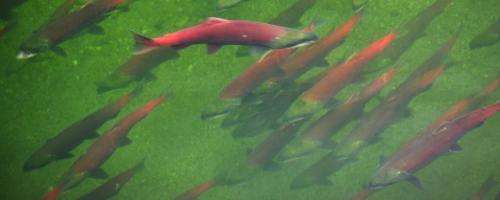New technique improves forecasts for Canada's prized salmon fishery

A powerful method for analyzing and predicting nature's dynamic and interconnected systems is now providing new forecasting and management tools for Canada's premier fishery.
In a paper published in the Proceedings of the National Academy of Sciences, Scripps graduate student Hao Ye, Scripps Professor George Sugihara, and fisheries coauthors in Canada describe how the technique, called empirical dynamic modeling, or EDM, improved forecasting for Fraser River sockeye salmon, a highly prized fishery in British Columbia.
Developed at Scripps Institution of Oceanography at UC San Diego by Sugihara, the McQuown Chair Distinguished Professor of Natural Science, the new technique uses archives of field data to drive predictions of future performance.
Salmon populations in this fishery can exhibit dramatic and seemingly unpredictable changes in annual recruitment (also known as the "returns" in counting fish populations). In one example, salmon numbered only 1.4 million in 2009 but then boomed to 28.3 million in 2010. The researchers applied EDM methods in advance of the 2014 recruitment for Late Shuswap, a dominant recruitment location in 2014, and outperformed traditional forecasts with a smaller error margin. The EDM technique predicted returns of between 4.5 million and 9.1 million fish, while the official forecast indicated a much broader range of 6.9 million to 20 million. The actual tally has been listed at (approximately) 8.8 million fish.
"My colleagues and I are optimistic that our new approach will be adopted into the official forecasts, after undergoing careful review by the policymakers," said Ye.
"Fisheries and Oceans Canada welcomes opportunities to examine alternative approaches which might improve the forecast of salmon returns in B.C.," said study coauthor Sue Grant of Fisheries and Oceans Canada.
Sugihara says EDM advances ecosystem forecasting because it uses real-world field data, along with an intricate backbone of mathematical modeling that can account for the complicated interactions of variables and components in an ecosystem. Traditional scientific equations make assumptions about ecosystem processes, he says, and such assumptions can quickly lead to erroneous results.
"Despite what we are learning about the complexity of marine ecosystems, ecosystem models with specified equations assume we understand how natural ecosystems work, and their failure at real prediction shows that we do not," said Sugihara. "Our paper provides a simple alternative: equation-free mathematical modeling. This approach allows the data to speak for itself, instead of shoe-horning ill-fitting data into preconceived equations. The bottom line is that the EDM approach forecasts accurately in real time."
Sugihara first applied EDM to the more than 65 years of data archived by the California Cooperative Oceanic Fisheries Investigations (CalCOFI), a program that provides valuable data for long-term fisheries and coastal resources management, and has since applied the technique to topics spanning from climate change to cosmic rays.
More information: Equation-free mechanistic ecosystem forecasting using empirical dynamic modeling, Proceedings of the National Academy of Sciences, www.pnas.org/cgi/doi/10.1073/pnas.1417063112
Journal information: Proceedings of the National Academy of Sciences
Provided by University of California - San Diego



















